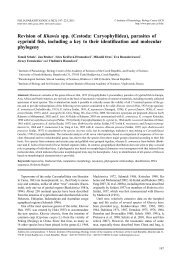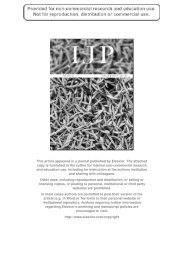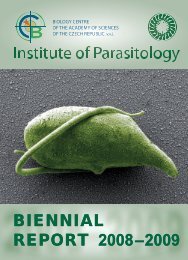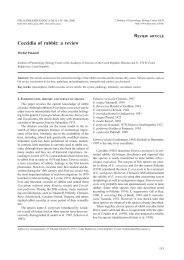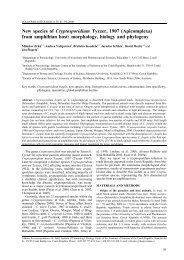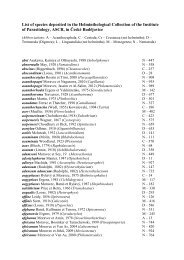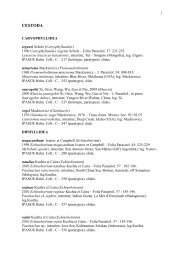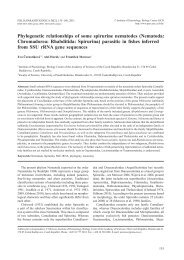Ahead of print online version Two species of Rhabdochona ...
Ahead of print online version Two species of Rhabdochona ...
Ahead of print online version Two species of Rhabdochona ...
Create successful ePaper yourself
Turn your PDF publications into a flip-book with our unique Google optimized e-Paper software.
cies in some features found in the male (Moravec 1975,<br />
Moravec et al. 2010). Since the conspecific male <strong>of</strong> the<br />
<strong>Rhabdochona</strong> (R.) sp. from L. kersin remains unknown,<br />
the specific identification <strong>of</strong> the present specimen is impossible.<br />
<strong>Rhabdochona</strong> (<strong>Rhabdochona</strong>) hellichi (incorrectly reported<br />
as R. (R.) belichii) was reported from iraq by Ali<br />
et al. (1987) from the cyprinid Luciobarbus xanthopterus<br />
Heckel (prevalence 11%) and from two <strong>species</strong> <strong>of</strong> catfishes,<br />
Heteropneustes fossilis (Bloch) (8%) and Mystus<br />
pelusius (solander) (reported as M. halpensis) (57%), <strong>of</strong><br />
the tigris river in Baghdad. However, the authors provided<br />
a poor description <strong>of</strong> their specimens and, moreover,<br />
the characteristic feature <strong>of</strong> this <strong>species</strong>, i.e., the widely<br />
bifurcate distal tip <strong>of</strong> the left spicule, is neither mentioned<br />
in the text nor is apparent from the accompanying photo<br />
(fig. 3b) <strong>of</strong> the male posterior end. Therefore, the belonging<br />
<strong>of</strong> these nematodes to R. hellichi may be questioned.<br />
recently, based on genetical and small morphological<br />
differences, Moravec et al. (2010) distinguished two<br />
sub<strong>species</strong> within <strong>Rhabdochona</strong> hellichi: the nominotypical<br />
sub<strong>species</strong> R. hellichi hellichi (Šrámek, 1901) parasitizing<br />
barbels (Barbus spp.) in Europe and R. hellichi<br />
turkestanica (skryabin, 1917) parasitic mainly in <strong>species</strong><br />
<strong>of</strong> Schizothorax and some related fish genera in Central<br />
and south Asia. in this connection, it is highly desirable<br />
to describe the male <strong>of</strong> <strong>Rhabdochona</strong> (<strong>Rhabdochona</strong>)<br />
nematodes parasitizing L. kersin in iraq to identify them<br />
specifically and, if they actually belong to R. hellichi, to<br />
determine their sub<strong>species</strong> based on morphological features<br />
and molecular data.<br />
ReFeReNCeS<br />
Ali N.M., SAlih N.E., Abdul-AMEEr K.N. 1987: Parasitic fauna<br />
<strong>of</strong> some freshwater fishes from Tigris river, Baghdad, Iraq. IV.<br />
Nematoda. J. Biol. sci. res., Baghdad, 18: 35–45.<br />
Al-TAEE A.F., ZANgANA M.g. 2011: Detection <strong>of</strong> parasitic nematodes<br />
in some fresh water fishes in Khazir River in Ninevah<br />
governorate. Iraqi J. Vet. Sci. 25: 29–38. (In Arabic with English<br />
abstract.)<br />
bilAl S.J., AbdullAh S.M.A. 2010: Helminthic fauna <strong>of</strong> some<br />
cyprinid fishes from Bahdinar River, northern Iraq. J. Ass.<br />
Arab Univ. Base Appl. sci. 8 (Year 2009): 17–29.<br />
booMKEr J., PETTEr A.J. 1993: Parasites <strong>of</strong> south African freshwater<br />
fish. III. <strong>Rhabdochona</strong> (<strong>Rhabdochona</strong>) versterae n. sp.<br />
(Nematoda: rhabdochonidae) from the spot-tailed robber, Alestes<br />
imberi Peters, 1852. onderstepoort J. Vet. res. 60: 23–27.<br />
dZhAlilov u.d. 1964: [rhabdochonid materials (<strong>Rhabdochona</strong><br />
Railliet, 1916) from fishes <strong>of</strong> the River Vakhsh and nearby<br />
lakes.] Izv. Akad. Nauk Tadjik. SSR, Otdel Biol. Nauk 1 (15):<br />
109–117. (in russian.)<br />
FroESE r., PAuly d. (Eds.) 2011: FishBase. World Wide Web<br />
electronic publication, www.fishbase.org, <strong>version</strong> 08/2011.<br />
goNZálEZ-SolíS d., MorAvEc F., coAd b.W. 1997: some nematode<br />
parasites <strong>of</strong> fishes from southwestern Iran. Zool. Middle<br />
East 15: 113–119.<br />
146<br />
<strong>Ahead</strong> <strong>of</strong> <strong>print</strong> <strong>online</strong> <strong>version</strong><br />
regarding R. gnedini, this <strong>species</strong> has been, for the<br />
first time, reported from Iraq by Bilal and Abdullah<br />
(2010), who recorded numerous specimens from Capoeta<br />
damascina (Valenciennes) and Capoeta umbla (Heckel)<br />
from the Bahdinan river (tigris river basin), northern<br />
iraq. However, the presented description <strong>of</strong> these specimens<br />
is very incomplete and some taxonomically important<br />
features (e.g., the size and position <strong>of</strong> deirids) are not<br />
described; the left spicule is reported to be longer (830–<br />
860) than that in R. gnedini (at most 750 – see Moravec<br />
1975); moreover, the definitive hosts <strong>of</strong> R. gnedini are<br />
principally barbels (Barbus spp. and fishes <strong>of</strong> related genera),<br />
whereas fishes <strong>of</strong> Capoeta spp. are mainly parasitized<br />
by some <strong>species</strong> <strong>of</strong> <strong>Rhabdochona</strong> noted for unusually<br />
large deirids, such as R. fortunatowi Dinnik, 1933,<br />
R. macrostoma Moravec et Mikailov, 1970 and R. tigridis<br />
rahemo, 1978. A female specimen <strong>of</strong> the latter <strong>species</strong><br />
(R. tigridis) (originally misidentified as R. fortunatowi,<br />
see Moravec et al. 2009) was reported by gonzález-solís<br />
et al. (1997) from Capoeta damascina in southwestern<br />
Iran. Therefore, the identification <strong>of</strong> Iraqi specimens as<br />
R. gnedini can be questioned and further detailed studies<br />
are necessary to determine whether or not these specimens<br />
belong to this <strong>species</strong>.<br />
Acknowledgements. We thank Pr<strong>of</strong>. Furhan t. Mhaisen for<br />
checking iraqi rhabdochonid <strong>species</strong>. thanks are also due to<br />
the staff <strong>of</strong> the Laboratory <strong>of</strong> Electron Microscopy, Institute <strong>of</strong><br />
Parasitology, BC ASCR, České Budějovice, for their technical<br />
assistance, and to Blanka Škoríková <strong>of</strong> the same institute, for<br />
her help with illustrations. this study was partly supported by<br />
the czech science Foundation (P505/12/g112) and the research<br />
project <strong>of</strong> the Institute <strong>of</strong> Parasitology, BC ASCR (Z60220518).<br />
KArvE J.N., NAiK g.g. 1951: Some parasitic nematodes <strong>of</strong> fishes<br />
– ii. J. Univ. Bombay, sect. B, Biol. sci. 19: 1–37.<br />
MorAvEc F. 1972: general characterization <strong>of</strong> the nematode genus<br />
<strong>Rhabdochona</strong> with a revision <strong>of</strong> the south American <strong>species</strong>.<br />
Acta soc. Zool. Bohemoslov. 36: 29–46.<br />
MorAvEc F. 1975: reconstruction <strong>of</strong> the nematode genus <strong>Rhabdochona</strong><br />
railliet, 1916 with a review <strong>of</strong> the <strong>species</strong> parasitic<br />
in fishes <strong>of</strong> Europe and Asia. Studie ČSAV No. 8, Academia,<br />
Prague, 104 pp.<br />
MorAvEc F. 2010: Some aspects <strong>of</strong> the taxonomy, biology, possible<br />
evolution and biogeography <strong>of</strong> nematodes <strong>of</strong> the spirurine<br />
genus <strong>Rhabdochona</strong> railliet, 1916 (rhabdochonidae, thelazioidea).<br />
Acta Parasitol. 55: 144–160.<br />
MorAvEc F., Ali N.M., Abul-EiS E.S. 1991: observations on<br />
two <strong>Rhabdochona</strong> <strong>species</strong> (Nematoda: rhabdochonidae) from<br />
freshwater fishes in Iraq, including description <strong>of</strong> R. similis sp.<br />
n. Folia Parasitol. 38: 235–243.<br />
MorAvEc F., SANToS M.d., brASil-SATo M.c. 2008: redescription<br />
<strong>of</strong> Cystidicoloides fischeri based on specimens from piranhas<br />
in Brazil, with erection <strong>of</strong> a new genus (Nematoda:<br />
cystidicolidae). J. Parasitol. 94: 889–897.<br />
MorAvEc F., SArAivA A., AbdullAh S.M.A., bilAl S.J., rAhEMo<br />
Z.i.F. 2009: two <strong>species</strong> <strong>of</strong> <strong>Rhabdochona</strong> railliet, 1916



